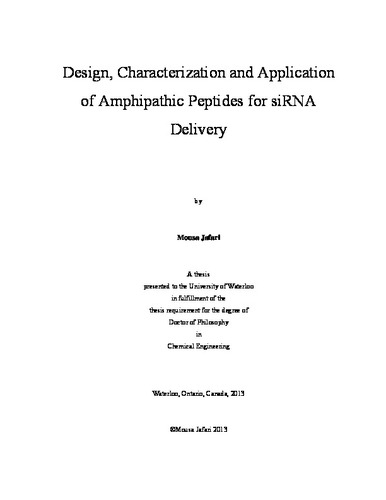| dc.description.abstract | Short interfering RNAs (siRNAs) are 21-23 nucleotide-long double-stranded RNA molecules that can trigger the RNA interference (RNAi). RNAi is a post-transcriptional gene silencing process whereby siRNAs induce the sequence-specific degradation of complementary messenger RNA (mRNA). Despite their promising therapeutic capabilities, siRNA-based strategies suffer from enzymatic degradation and poor cellular uptake. Several carrier-based approaches have been employed to enhance the stability and efficiency of siRNA delivery. Considering their safety, efficiency, and targeting capabilities, peptide-based delivery systems have shown great promise for overcoming the main obstacles in siRNA therapeutic delivery. Peptides are versatile and easily designed to incorporate a number of specific attributes required for efficient siRNA delivery.
This thesis focuses on the design, characterization and utilization of a new class of amphipathic peptides for siRNA delivery. The study includes: (i) designing amphipathic, amino acid pairing peptide sequences for siRNA delivery, (ii) siRNA delivery experiments in vitro to evaluate transfection efficacy of the designed peptides, (iii) physicochemical characterization of the interaction between promising peptides and siRNA, and (iv) identifying internalization pathway and kinetics of a promising peptide, C6M1.
The peptide C6, an 18-mer amphipathic, amino acid pairing peptide, was designed as an siRNA delivery carrier by incorporating three types of amino acids, i.e., arginine, leucine, and tryptophan. This peptide adopted a helical structure upon co-assembling with siRNA. The C6-siRNA co-assembly showed a size distribution between 50 and 250 nm, confirmed by dynamic light scattering and atomic force microscopy. The C6-siRNA interaction enthalpy and stoichiometry were 8.8 kJ.mol-1 and 6.5, respectively, obtained by isothermal titration calorimetry. A minimum C6:siRNA molar ratio of 10:1 was required to form stable co-assemblies/complexes, indicated by agarose gel shift assay and fluorescence spectroscopy. C6 showed lower toxicity and higher efficiency in cellular uptake of siRNA, compared with Lipofectamine 2000, a lipid-based positive control. Fluorescence microscopy images confirmed the localization of C6-siRNA complexes in the cytoplasm.
In order to enhance the solubility and delivery efficiency further, a modified peptide, C6M1, was designed by replacing three leucine with tryptophan residues in the C6 sequence. The fluorescence assay confirmed that the sequence mutation significantly increased the solubility of C6M1. C6M1 adapted a stable helical structure in saline or upon interaction with siRNA. The toxicity assay showed lower toxicity of C6M1 with an IC50 (the concentration of peptide at 50% cell viability) of 22 μM, compared with C6 with that of 12 μM. Naked siRNA was completely degraded after 4 h incubation in 50% serum, while the siRNA in complex with C6M1 was preserved even after 24 h. Western blotting showed a significant decrease in GAPDH protein contents (75%) in CHO-K1 Chinese hamster ovary cells, 48 h after treatment with C6M1-GAPDH siRNA complexes.
The interaction of C6M1-siRNA complexes with cell surface and the mechanisms involved in the internalization of the complex in different size ranges were studied. Heparin and chlorate treatments revealed that the electrostatic interaction of the C6M1-siRNA complex with heparan sulphate proteoglycans at the cell surface is required to trigger the uptake process. Using endocytic inhibitors, it was found that small C6M1-siRNA complexes (mean ~155 nm) mainly enter CHO-K1 cells through an energy-independent mechanism, most likely involving direct translocation. In contrast, large complexes (mean ~460 nm) internalize the cells mainly through a lipid raft-dependant macropinocytosis. The integrity of the cytoskeletal components also showed significant impact on the efficient internalization of the C6M1-siRNA complex. The kinetics experiments confirmed the fast internalization of small complexes (with uptake half-time of 25 min) in comparison to large complexes (70 min). This work provides essential information for peptide design and characterization in the development of amphipathic peptide-based siRNA delivery. | en |

